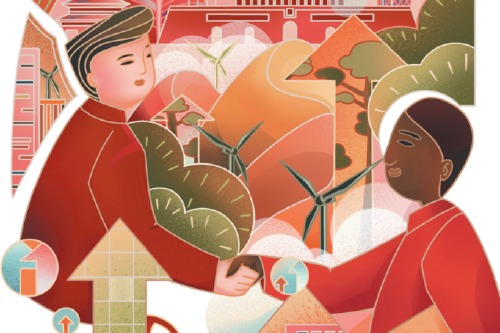Guardian of nature
China's clear waters and green mountains are invaluable examples as well as assets

China's clear waters and green mountains are invaluable examples as well as assets

On Aug 15, 2005, Chinese President Xi Jinping visited Anji, a wonderful hillside town surrounded by forest within an hour or so drive from Hangzhou. He was the Party chief of Zhejiang province and famously said that "clear waters and green mountains are invaluable assets".
This idea has shown its transformative power. At that time, development in China came with heavy pollution, now it is pursuing green growth. At the time, all the focus in China was on highest possible economic growth, now high quality growth is front and center.
Anji county, which once relied on mines and cement and was plagued by heavy industrial pollution, is now a national 4A beautiful scenic town, named a Best Tourist Village by the United Nations World Tourism Organization. I visited Huzhou city, where Anji is located, last week. I saw a city brimming with ambitions for being a global eco-city hub. Huzhou hosts first class conservation wetlands where endangered birds are being brought back from the brink with top modern science. It is home to wonderful forest resorts and to amazing waterside tourism at Lake Tai.
Having originated in the United States in 1872, national parks have now been founded in more than 100 countries. President Theodore Roosevelt, himself an outdoors man, once said that "there is nothing as American as a national park".Now China is running with this American idea. What makes China's national park system stand out?
One is speed. From the proposal of the construction plan to the establishment of the first five national parks, it took only eight years, with the fastest, the Hainan Tropical Forests National Park, taking only two or three years.
Second range. The first five national parks cover a total area of 230,000 square kilometers. By 2035, around 50 national parks will be created, and the number may eventually total as many as 80. The country's determined will to ensure ecological protection is evident.
Third community outreach through win-win policy. The Three-River-Source National Park is China's largest and the world's highest altitude national park. It provides a valuable experience on improving ecological protection, alleviating poverty and promoting community development at the same time.
Situated in Qinghai province in Northwest China, the park was constructed in an underdeveloped area. One of the big challenges was to gain the local herdsmen's support and secure the communities' livelihoods. A public welfare mechanism has been established, ensuring each household gets a park ranger job with a stable monthly salary. Public service capacity has been greatly enlarged, such as medical care, pensions, education and e-commence. Local herdsmen have also been guided to develop family ranches. This is key to conservation everywhere, the mobilization of local communities. A beautiful China must be built with local buy-in. The conservation successes in Africa, India and Europe are also based on making local people the front line defenders of nature.
China's vast territory and rich nature are home to a host of rare and endangered species, including the Asian elephant. In order to take good care of the largest mammal in Asia, well-planned conservation efforts have been put in place. Success is visible as the habitats for Asian elephant are expanding and its population growing. In 2021, a herd of wild Asian elephants made global headlines when they wandered hundreds of kilometers through Yunnan province from their jungle paradise all the way to the province's capital city of Kunming and back.
Mangrove conservation and restoration is another important accomplishment of China's green effort. Known as "coast guard", the ecological functions of mangrove forests range from dissipating winds and waves to purifying ocean water, from sheltering wildlife to storing huge amounts of carbon. President Xi last month paid a visit to the mangrove area on Jinniu Island in Guangdong province, South China and said that mangroves are "a national treasure" and should be well protected like the human eye. China is one of the few countries in the world with a net gain in its mangrove cover. By 2025, over 18,000 hectares of mangroves will be created and restored. Shenzhen, Guangdong province, will host the first international mangrove center. And the Belt and Road Initiative provides a platform where China can share its mangrove experiences with the world.
The 10-year fishing ban in the Yangtze River, the ambitious tree planting plans, successful conservation of giant pandas in Sichuan province and snow leopards in western China, the greening of the Kubuqi Desert in the Inner Mongolia autonomous region, the effective river clean-ups in Zhejiang and Jiangsu provinces, the ecological redline system, the restoration of West Lake in Hangzhou or Dianchi Lake in Kunming — China has a lot of best practice on nature conservation to share with the world.
Development can be achieved without the destruction of nature. When Mother Earth smiles, we flourish. Actions and efforts in creating harmony between man and nature need to win the hearts and minds of people. Any conservation effort must be people-oriented and aimed at combining economy and ecology. Mass greening campaigns prioritize the well-being of the people and the benefit of communities.
From beautiful villages to green cities I see the future of green as a triple-win formula for the people, the economy and the ecology. President Xi's Anji speech provided a direction for China, and its progress will have a massive positive impact on the world. While applauding China's great achievements and hard work, we should exchange best practices and learn from each other. I am confident China will continue contributing wonderful green stories. Let's all look forward to the Beautiful China by 2035.
The author is president of the Belt and Road Initiative Green Development Institute and former executive director of the United Nations Environment Programme. The author contributed this article to China Watch, a think tank powered by China Daily.
Contact the editor at editor@chinawatch.cn.

































